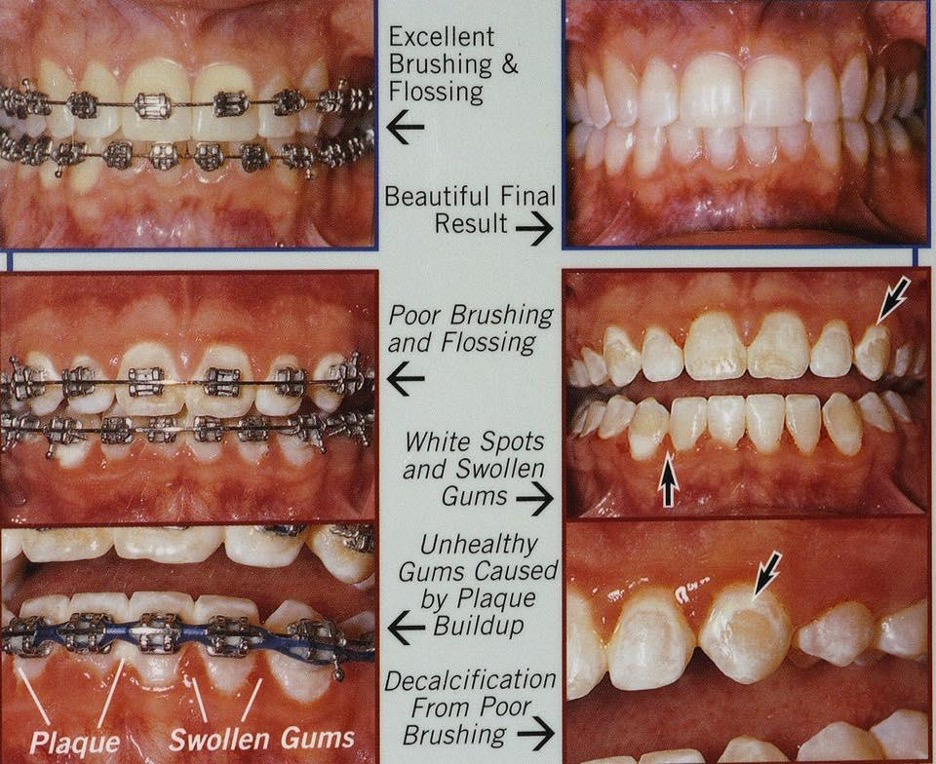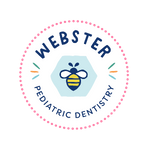Your Orthodontic Care Kit
When a patient starts orthodontics in our office, they are given an Orthodontic Care Kit which contains samples of all the items they will be using during orthodontic treatment. It will contain an instruction pamphlet, a travel toothbrush, dental floss, floss threaders, interdental brush, and ortho wax. Our staff will train each orthodontic patient how to care for their braces. We not only want teeth to be straight following orthodontic treatment – we also want them to be healthy and cavity-free!
Brushing with Braces
It is very important to brush your teeth well (and more often!) during orthodontic treatment to keep the teeth and gums healthy. Brush your teeth and gums 3 to 4 times per day with a soft toothbrush, after every meal and at bedtime, above and below the brackets. We will supply you with a travel toothbrush for brushing after lunch at school.
If food and plaque remain at the gum line during treatment, white spots develop that do not go away (almost similar to scarring). These are early signs of cavities and they often happen on the front teeth.

Dental Floss & Interdental Brushes
Daily flossing with floss threaders is highly recommended. This can be done at any time of the day or night. Pick a time of day that works best for you. We recognize that it takes a long time to floss teeth with braces! While it’s ideal to floss your teeth daily, flossing may be easier if you decide to floss your top teeth one day, and your bottom teeth another day. Again, flossing daily is deal, but flossing SOME of the time is better than flossing NONE of the time.
We’ll also teach you how to use an interdental brush for cleaning in between your brackets. This will be important to use because there are many more areas that are susceptible to decay while you are wearing braces.
Fluoride use
We recommend that our orthodontic patients rinse with a fluoride rinse (such as ACT Fluoride Rinse) daily. If your brushing needs improvement, we’re noticing early signs of cavities or you’re at high risk for cavities, we may prescribe a high-strength fluoride toothpaste. Brush for 2 minutes twice daily. Spit. Do not eat, rinse or drink for at least 30 minutes after use.
General Soreness
When braces are first placed and even when wires are adjusted, it’s normal for your mouth to be sore; after all, the appliances are putting pressure on your teeth to get them to move. This tenderness may remain for 3 – 5 days after an adjustment appointment. We recommend soft foods, and acetaminophen or ibuprofen if needed for pain. The lips, cheeks and tongue may also become irritated for up to two weeks as they toughen and become accustomed to the surface of braces. The orthodontic wax that we provided to you can be placed on the brackets to alleviate the irritation.
Loosening of Teeth
Don’t worry if teeth start to feel loose during treatment. This is normal and is to be expected. The teeth must loosen first so they can be moved into their new corrected position. Once the teeth are moved, they will again stabilize into their new positions.
Loose Wire, Brackets, or Bands
Occasionally brackets break off, wires bend or bands loosen. If a bracket on a tooth loosens, call our office. If a wire is poking in the back of the mouth and our office is closed, you can use nail clippers to cut it. If you’re unable to do so, use some ortho wax to cover it until you can get in for an appointment. You can also use the wax to cover up brackets or hooks that may irritate your cheeks and lips. Roll the wax in a ball to soften and place it on the bracket. Press and squeeze the wax to mold it around the bracket. Broken brackets, and loose wires and appliances can be taken care of when our office next opens; there’s no need to call the emergency line.
Foods to Avoid
Unfortunately, some foods are off-limits during orthodontic treatment so brackets don’t break. Foods to avoid include popcorn (Pirate’s Booty without kernels is okay), gummy bears, crusty bread and bagels, corn on the cob, and whole apples and carrot sticks.
Athletes and braces
Even more than before, it’s critical to wear a mouthguard for contact sports such as soccer, lacrosse and hockey. Protect your investment in your smile from injury! Call our office to be fit for a custom mouthguard or purchase a boil-and-bite version. If your athlete has an injury on the field or elsewhere, give our office a call to reach the on-call pediatric dentist.
Retainers After Treatment
There are only two places your retainer should be – in your mouth or in your case! Dogs love to chew retainers and sometimes retainers find their way to the trash during school lunches. If you need a replacement set, please call us the next day business day as teeth will quickly relapse into their previous positions. It’s important to know that retainers are for life. Retainer wear should be around-the-clock initially and then can be reduced to a frequency as advised by your orthodontist.
